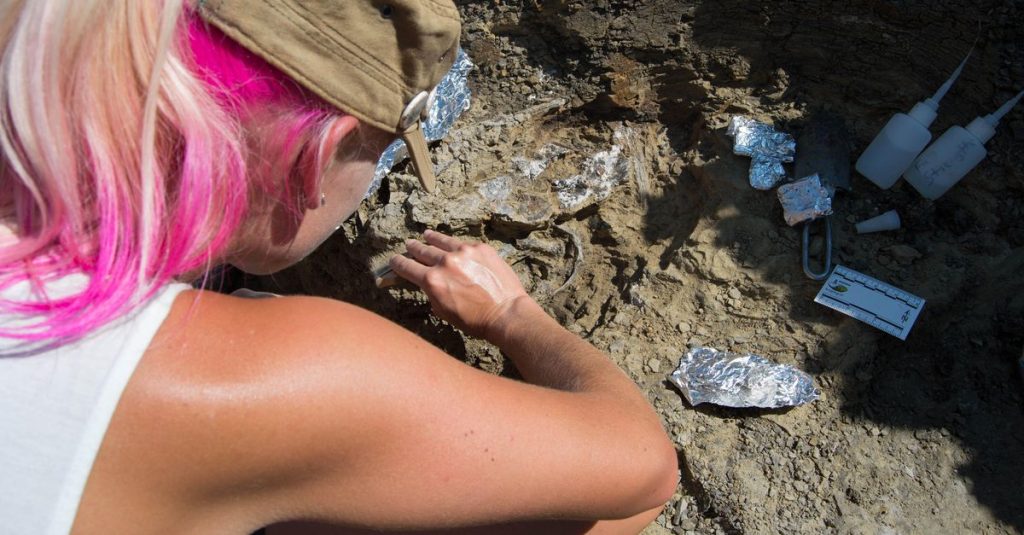When the deadly meteor hit the dinosaurs, it was spring in the northern hemisphere. This concludes A team of mostly Dutch researchers this week in nature, based on extensive research on fish fossils. The season may explain why species in the southern hemisphere are much less affected by the effect.
It has been known since the 1970s that the Mexican Yucatan Peninsula was hit by a meteorite about 66 million years ago. This Chicxulub effect was cited shortly after its discovery as a plausible explanation for the sudden extinction of the dinosaurs. In 2019 he appeared in the magazine PNAS Published who provided evidence supporting this theory, based on excavations in North Dakota. Excavations have also revealed a large number of fossil fish: sturgeon and spoon sturgeon, almost all with their tails pointing in the same direction. The meteorite caused shock waves in the continental crust, called seiches, that buried the fish alive. They also had glass droplets in their nostrils: ‘microtectites’, which rained down in the hours after the impact.
Thin paper inserts
“We have now examined six of these fish in detail,” says Melanie While, lead author of the current study. naturePhD student in the article at Uppsala University, Sweden, and former student at VU University, Amsterdam. “Using thin slices and 3D X-ray scanning from a synchrotron, a specific type of particle accelerator, we were able to observe seasonal growth streaks in fish bones.” This showed that the animals were at the beginning of their growing season: typical of spring. The distribution and shape of cells in bone tissue also indicate spring growth. During: “We also crushed some bone material from one of the fish to analyze the ratio of carbon isotopes. This showed that at the time of their death a reasonable amount of plankton was already available as food, but not the maximum yet. Another sign that they died in the spring.”
Previous research estimated that the meteor impact caused the extinction of 76 percent of all species, including flightless dinosaurs, pterosaurs, ammonites, and nearly all marine reptiles. Sometimes this happens immediately, as with fish. During: “We demonstrated that tectes are only found in the gills, and they do not end up further in the body, for example through digestion.” For other species, extinction was an indirect process.
The spring of that time is not one to one to compare the spring of now
It has already been shown that species in the northern hemisphere are particularly affected. In light of this, it is interesting that the season of forcing is now known. During: „Autumn was in the Southern Hemisphere during the impact. Some species can already hibernate underground and thus escaped, for example, from the large-scale wildfires that started in many places after the impact. But more research is needed to get more clarity on this.”
In any case, there were certainly strong seasonal influences at the time at the site where the fish fossils were found, says Jeroen van der Loeb, co-author of the article and Durings supervisor at VU. “At that time, the site was located at 50 degrees north latitude, average summer temperatures were about 19 degrees Celsius and winter temperatures were about 5 degrees Celsius.” Today, North Dakota is more to the south. Co-author Dennis Foten: “And you have to realize that not only the location of the continents but also the length of the day at the end of the Cretaceous was different than it is today. On average, the days were shorter, and you had more days in one year. Therefore, the spring of that time cannot be compared with our current spring. Van der Lubbe: “At first we were hoping to get the fossil shell material in addition to the fish. This allows you to more accurately determine the time of the season. But who knows, that will come later.”
/s3/static.nrc.nl/images/gn4/stripped/data82419096-c754d9.jpg)
Photo by Joshua Knuppe
Remarkably enough, a few months before nature– The article also published another, in which a possible timing of the impact was mentioned, In the sister magazine Nature Scientific Reports† Its principal author was Robert de Palma, the American paleontologist who discovered the North Dakota excavation site in 2014. He gave a broader indication of the period of impact: late spring and early summer. Van der Loeb: „De Palma was aware of our manuscript. He submitted a similar article when ours was already under review. Due to the careful reviews, it took longer before our article was finally accepted. Oddly enough, the data was not included in that article, making it difficult to properly evaluate and compare. In any case, it is good to see that our independent studies provide consistent results.”
A version of this article also appeared on NRC on the morning of February 24, 2022

“Total coffee specialist. Hardcore reader. Incurable music scholar. Web guru. Freelance troublemaker. Problem solver. Travel trailblazer.”







More Stories
GALA lacks a chapter on e-health
Weird beer can taste really good.
Planets contain much more water than previously thought